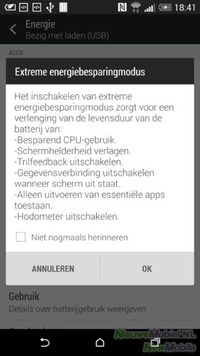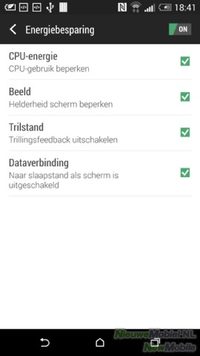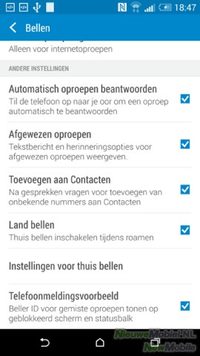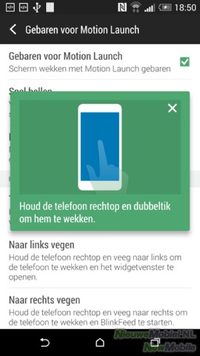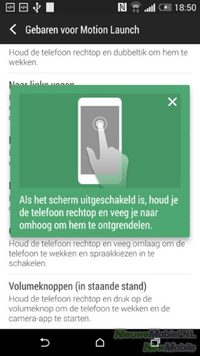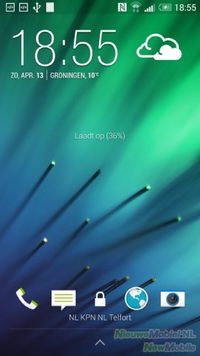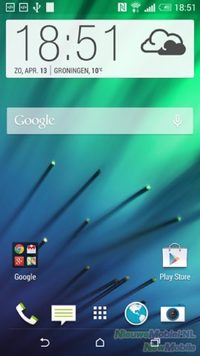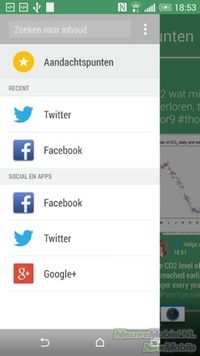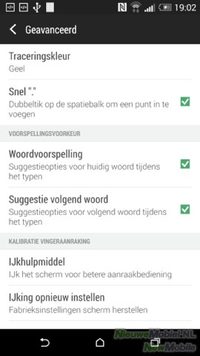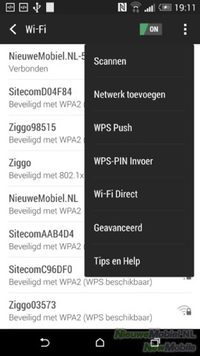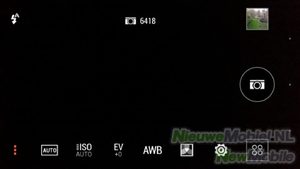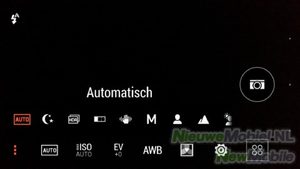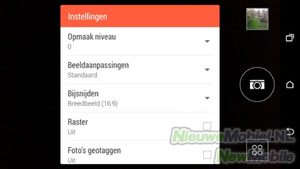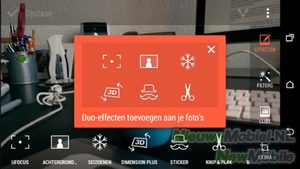HTC One M8 review
New One or improved One?
HTC's new flagship has reached the Dutch stores and our critical eye. The One M8 is a further developed One with two cameras at the rear, opening up entirely new possibilities.

The HTC One M8 is the successor to the One that was voted the most beautiful phone last year. One thing they have already done better than the previous One and that is the availability right after the launch of the device. Nice was the One for sure but according to HTC it could be even better and therefore the One M8 has some improvements. The unibody has a new finish and is more streamlined than its predecessor.
Just like its predecessor, the M8 has to compete against a Samsung Galaxy. The outspoken competitor of the M8 is the Samsung Galaxy S5, but Sony's Xperia Z2 should not be forgotten. Besides its double camera and metal unibody, the M8 also has a 5.0-inch Full HD screen and BoomSound speakers at its disposal.
This review has been made possible by Belsimpel.nl which has the aircraft in stock in the versions 'Gun Grey' and Silver.
What's with the device?
The flat, square box contains paperwork underneath the device, including a quick start guide and a sheet with the tool to eject the trays for the SIM and microSD cards. The other half of the box contains the USB cable with adapter and the in-ear headset with red rubber sleeves in three sizes.
We also got a nice cover. Unfortunately not yet the new Dot View Case, but a tightly fitting, silicone case that will provide the device with the necessary protection in case of a fall.
Appearance
The M8 is very eye-catching. In a positive sense. Our test sample in the 'Gun Metal' version is an almost dazzling appearance. It is not flashy but radiates quality. The M8 is much more elongated than its predecessor and its corners and edges are nicer rounded. This gives it a much slimmer appearance. Where we found a small defect in its predecessor, the M8 is really no problem. This is the next level in metal unibody phones.


".
Above and below the screen we again see two grids for the microphone and earpiece but also for the BoomSound speakers. These now give an even louder but also clearer sound. In the upper grid there is another LED-notification light hidden.
The M8 no longer has physical function keys. HTC has finally chosen to use virtual keys that belong to Android. Nevertheless, there is still a wide black border underneath the screen with the HTC logo.


".
On the left side of the device is the slot for the drawer of the nanoSIM card. On the right we find the same slot but this time for the microSD card. Underneath are the volume buttons.


".
On the bottom of the unit we find the connections for the headset and the USB cable.
The top is the only place where we see plastic. Besides the power button there is also an infrared sensor to use the M8 as a remote control. Because of the length of the device, the top is probably not the most practical place for the power button as you also need it to activate the screen, but HTC has come up with something clever. Further on in the review we will discuss this in more detail.

At the back, of course, the two camera lenses stand out immediately. The main camera sits in a fairly regular spot with a double LED flash in two different shades next to it. The other camera is very close to the edge. Furthermore, the back is a nice bulge of brushed metal.
The M8 is just wide enough to hold on well. Because of its ergonomic shape and rounded edges, it also lies very comfortably in the hand. Perhaps the only disadvantage is that the metal offers little grip.
Endurance
The battery of the M8 is at 2600 mAh slightly larger than that of its predecessor and that is noticeable. With average use, the M8 manages to last at least a full day with a handful of hours of slack. With average use we mean regularly checking news and social media, synchronizing two email accounts via push, watching or listening to multimedia several times and occasionally making a phone call. All this preferably via a WiFi connection, apart from making a phone call. In order to stretch stamina, the data connection can be switched off automatically during long periods of inactivity.
".
In addition, the M8 is doing its best to last as long as possible. When the battery level drops below 15 percent, energy saving is automatically turned on. This means that CPU usage and screen brightness are reduced, vibration feedback is turned off and data connection goes into sleep mode when the screen is turned off. Unfortunately, the power saving does not automatically turn off when you put the device on the charger or the battery level exceeds 15 percent.
There is also the extreme energy saving mode. This switches off almost all functionality and keeps only the phone, messages, mail, calendar and calculator available. However, you can set the percentage of this function at which it should be turned on again.
Call quality
The phone application has not been radically changed, but it does look a bit tighter and more modern. Via smartdial on the numeric keypad, the desired contact is quickly found. But a QWERTY keyboard can also be opened. Tabs on the left and right contain the logbook, favourites, all contacts and groups.
".
By default, the option that you can answer calls by lifting the phone to your ear is checked in the settings. We have no complaints about the sound quality while calling.
Display
The 5.0-inch screen has a resolution of 1920 × 1080 pixels, which results in a pixel density of 441 pixels per inch. This results in a very detailed and easy to read screen. Colors are incredibly fresh and bright and white is really white. Without any blue or yellow haze. Drawing style, font size, brightness, time-out and daydreaming are adjustable.
".
But that's not all. The M8 also features Motion Launch. This allows the screen to be woken up by gestures. Tapping the screen twice shows the lock screen. However, by dragging up the screen is also immediately unlocked. The start screen, BlinkFeed and voice dialing are also possible by dragging left, right and down respectively. It is an incredibly easy way to use the device quickly. Although the chance of accidentally unlocking the screen is of course slightly greater.
".
Menu
Traditionally, HTC takes a thorough look at the appearance of Android and Sense 6 is no exception. Sense is the shell that HTC puts over Android to give it its own look and user experience. In the early days of Android, it was very pleasant for consumers that HTC put so much effort into making the interface look beautiful. Nowadays Android is a lot more beautiful and mature but at HTC they still try just as hard to adapt it. At Sense 5 on the HTC One we weren't that broken but Sense 6 hits the nail on the head again. Under Sense the M8 runs on Android 4.4.2. The most recent version. In general Sense is now more similar to standard Android.
".
The most important change is the fact that the interface has become tighter and flatter overall. The color palette has changed slightly and has been fitted more thematically. The M8 HTC BlinkFeed is located on the left most start screen, where normally Google Now is located. It still doesn't meet a need for us, but it looks a lot better. The idea of BlinkFeed is that you can see the latest news and the most important updates of your social media at a glance. There is a fairly wide choice of news sources but you still can't add RSS feeds yourself.
".
Fortunately, at the back of the notification menu that is hidden under the status bar, we find shortcuts to setting functions again. This functionality was missing in Sense 5 and is actually indispensable. This overview can be adjusted by the user, but the maximum number of shortcuts is twelve anyway.
".
The application menu is still a grid that needs to be scrolled through horizontally. This can be sorted in three ways and in two different grid sizes. Luckily, on the first page of the menu there is no longer that silly big clock with the current weather at the top. The menu is again fully dedicated to apps.
".
Phonebook
The phonebook is fully integrated in the previously described phone application. Apart from the SIM card or Gmail, contacts can also be retrieved from all kinds of other online accounts. After synchronizing contacts, the phone can propose automatic contact links. This way, you have profile photos but also all kinds of contact information directly together.
When you have synchronized multiple accounts you can indicate at the top of the screen from which sources contacts should be shown. There are a number of sorting options in the settings. As far as we are concerned, by far the most convenient option is to only display contacts with a phone number.
Messaging
Although you might use it less and less, the M8 of course has a message app. Nowadays it is also possible to set Hangouts from Google+ as the standard application for SMS and MMS. HTC's mail-app has been renewed and streamlined. Adding an account is a piece of cake and in principle the settings are created automatically. Messages in folders other than your inbox can also be automatically synchronized and notifications will be shown for them. Unfortunately there is no widget available for the HTC mail app itself.
".
HTC's virtual QWERTY keyboard is very good and easy to use. Typing is very pleasant, even with two fingers. The keyboard is fast and can be adjusted to your personal preferences via the settings. It is possible to use prediction for two languages at the same time, but we prefer to switch between two or more languages.
In addition to typing, text can also be entered by sliding a thumb across the keyboard from letter to letter. Once you have mastered this, it goes a lot faster and the word prediction does a good job here as well.
Connectivity
As mentioned, in Sense 6 the user has access to a menu with shortcuts to settings from the home screen. Of course, this also includes numerous connection options. Think WiFi, Bluetooth, airplane mode and mobile data. But also NFC, WiFi hotspot and media output. The M8 is well equipped when it comes to connectivity and everything works properly.
".
The M8 is even double packed for internet browsing because it has Google's Chrome and HTC's own browser. In terms of appearance and functionality they hardly avoid each other. HTC's browser can be displayed fullscreen but Chrome can then synchronise with Chrome on your PC. Neither of them can handle Flash and they perform equally with zooming. The HTC browser only stopped a bit when scrolling through long pages for unclear reasons.
Camera
As a user of the M8 you still have to make do with only 4 megapixels in your camera. However, these are so-called UltraPixels and you now get a second camera. This second camera is a bit of minor importance because when shooting pictures you don't notice that it is there. So you will not see it in the picture when you hold your finger in front of this second camera lens.
The interface of the camera is also included in the transformation of Sense. It is tighter and clearer. If you keep the camera horizontal, there is a square in the lower right corner with four dots to switch between the different recording modes. In the other corner is a shortcut to your last shot and the gallery. By swiping from right to left across the image, you can switch between the front and back camera.
In the upper left corner there is a button for the flash. Opposite there are three dots that betray the presence of the settings menu. First you will see the choices for exposure, ISO, brightness, white balance and filter. Finally, there is the more extensive options menu. This menu contains formatting level, image adjustments, cropping, grid, geotag, display, self timer, continuous recording and camera and volume control options. Different combinations of settings can be saved as separate camera options.
Activating the camera, focusing and printing go very smoothly. The photos taken in daylight look good on the camera, but on a larger screen the weak spots soon become clear. The number of megapixels is on the low side anyway, so sharpness is quickly lost. Exposure doesn't go well either. This mainly causes white, overexposed spots.
Indoors, on the other hand, the camera scores considerably better. Focus and prints respond quickly but that does not lead to underexposed photos. The two-tone flash does a good job by illuminating the image less shrill. The color reproduction is also still neat and tidy.
Because of the extra lens you can, after taking the picture with the help of so-called duo effects, fool around with the image in the gallery. Think about adjusting the focus, but also apply a 3D effect so that it looks as if a photo has depth when you move the phone or paste a person from one photo into another.
Existing programs
The M8 comes standard with the apps 7digital, stocks, calendar, car, calculator, downloads, Drive, Facebook, Fitbit, FM radio, photos, gallery, voice search, Google+, Hangouts, HTC apps, HTC backup, HTC guide, setup, Kids mode, clock, scribble, music, parent dashboard, Play, Polaris Office 5, voice recording, tasks, tips and help, TV, Twitter, Weather, YouTube, flashlight and Zoe.
".
All in all, this is a collection that we know about from HTC. Complete but not so excessive that it will overwhelm your whole phone. Nevertheless, you may not need all the apps, so it's nice that you have the option to hide apps in the menu. If you're not interested in a fitness app like Fitbit or children's apps like scribble and child mode, you can at least make them invisible.
Extras
As said, the M8 also has a built-in infrared transmitter. With this you can control your TV as usual. Moreover, the new Sense includes an interactive program guide. This allows you to quickly find the right TV programme. Once in operation, Sense TV even gives recommendations for programs that fit your preferences. There is also extra attention paid to sports. You get a signal on which channel the match is being broadcasted and you also get standings and statistics.
".
Conclusion
It's been a long time since a HTC device convinced us like the One M8, but this time the Taiwanese manufacturer hits a lot of nails on the head again. Both the external design of the device and the internal design of the Sense 6 interface appeal to us. This makes the M8 an old-fashioned, user-friendly Android phone like we were used to from HTC in a high-quality, well-groomed jacket. It may be a bit long to sit unnoticed in your pocket, but at the same time it's nice to be reminded of such a beautiful possession every now and then.
Because HTC refuses to participate in the megapixel race, the camera is still a bit difficult to pigeonhole. In the sunny outdoors it doesn't perform as well as other phone cameras, while that is usually their strong point. However, the camera works nice and fast and performs better in less ambient light.
It is a pity that the second camera is only used for special effects and not to further improve the photo quality. Moreover, the editing options that the extra lens allows are still hidden in the menu of the photo gallery. This makes it more of a fun gimmick than a qualitative addition.


